Fort Kochi - Overview of Dutch-related tombs at the Dutch Cemetery
Over the past 130 years, several inventories have been carried out at the Dutch Cemetery, of which Cotton's List of inscriptions on tomb and monuments in Madras (1905/1945) is the most famous. However, Cotton did not identify all monuments as Dutch, which were recognized in later inventories. Some monuments, on the other hand, have disappeared or their text plate is no longer legible. The table below offers an overview of several inventories of the Dutch Cemetery. And presented here is an visual overview of grave monuments found in 2020 by the joint team of Dodenakkers.nl (René ten Dam) and the Cultural Heritage Agency of the Netherlands (Leon Bok and Nanette de Jong). Also are mentioned the two monuments previously recorded by Cotton and the one by Singh, which all three not found by the 2020-team.
| Name | Map | Cotton | Barendsen | Singh * | Dodenakkers/RCE | |
|---|---|---|---|---|---|---|
| #\year | 1905/1945 | 1966 | 1894/2007 | 2020 | ||
| 1 | Johan Daimichen | E4 | yes | yes | yes | yes |
| 2 | Aletta Thiel | D10 | yes | yes | no | yes |
| 3 | Jacob Weinsheimer | D7 | yes | no | no | yes |
| 4 | Van Haeften Van Shenar | - | no | no | yes | no |
| 5 | Johannes van Blankenberg | E5 | yes | yes | yes | yes |
| 6 | John Adam Cellarius | D3 | yes | yes | no | yes |
| 7 | Jacob Krantz and Maria de Rode | - | yes | no | yes | no |
| 8 | Adriaen Poolvliet | K6 | yes | yes | yes | yes |
| 9 | C and C ** | B7 | no | yes | no | yes |
| 10 | Dorothea Zeijsig | F5 | yes | no | yes | yes |
| 11 | Cornelia Vogt | C8 | yes | yes | yes | yes |
| 12 | Daniel van der Sloot | - | yes | no | no | no |
| 13 | Samuel Homans | D1 | no | yes | no | yes |
| 14 | Helena Elisabeth Muller | H2 | yes | no | yes | yes |
| 15 | Johannes and Sara Wolff | F10 | yes | yes | yes | yes |
| 16 | Unknown, aged 82 | G5 | no | no | no | yes |
| Total | 12 | 9 | 9 | 13 |
* A. Singh actually refers to List of European & C. tombs in the Malabar district, Malabar Collectorate press (1894 Calicut). She didn't do an inventory herself. The booklet is not available at the moment, so for the time being we refer to Singh.
** This monument was first identified by B. Barendsen in V. O. C. vestigingen aan de Malabarkust (1966). It is possibly Dutch, but could also be a British child's grave.
More information on the history of the Dutch Cemetery in the main article.
Map of the Cemetery
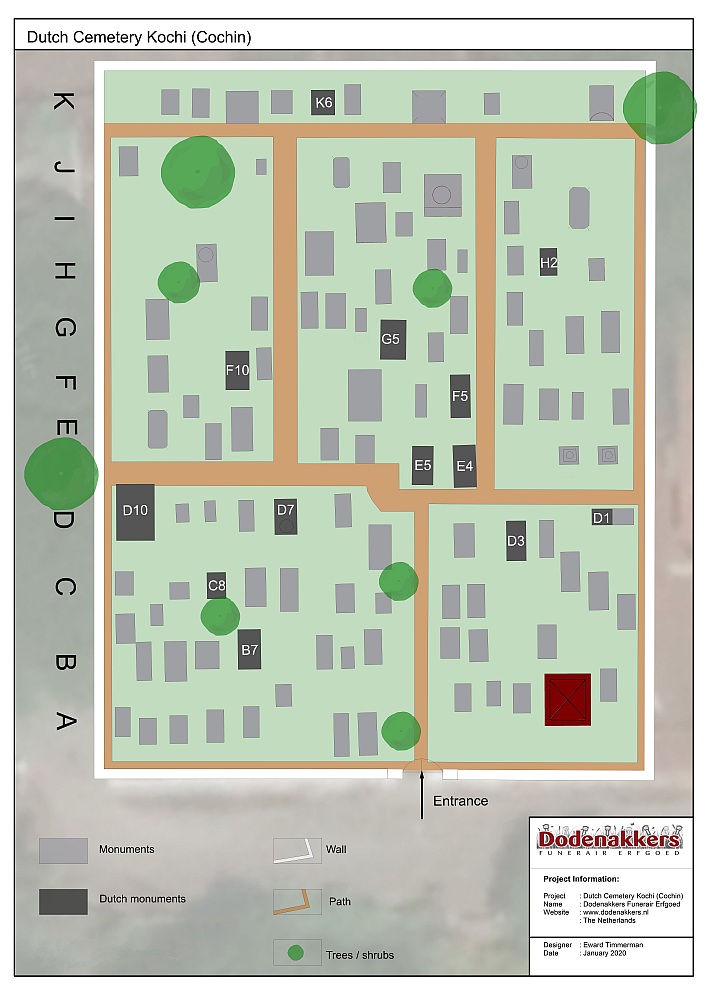
The numbering is based on Barendsen (1966), but in some cases deviates from it. Full version opens in new window.
1. Johan Daimichen (1728 - 1784) [E4]
The tomb of Johan Daimichen is remarkable from a Dutch perspective, as it depicts a coffin on top, which is not very common. Daimichen still experienced that he became a grandfather, but no longer that he became the ancestor of a family that would have a prominent place in Kochi for a long time and that would grow into a very prosperous family. The family would also leave its mark on the Dutch cemetery. The text on the monument: Hier rust / Ter salige opstandigen het lyk / van weledelen Heer / Johann Daimichen / In leeven onderkoopman en sekretaris van Politsie ge- / booren te Lubeck de 11 April 1728 / obiit den 30 augustus 1784. In translation: Here rests / awaiting his resurrection the corpse/ of the well-born sir / Johan Daimichen / in his life junior merchant and secretary of police / born in Lubeck on 11 April 1728, died 30 August 1784.
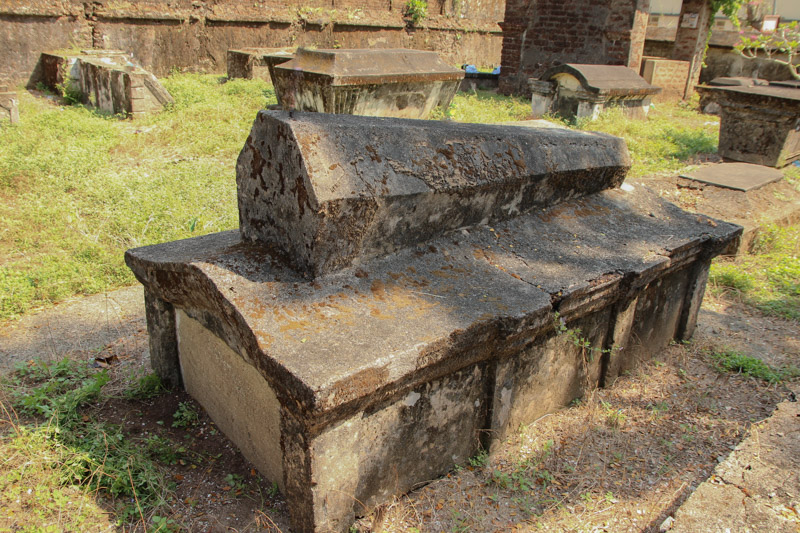 Tomb of Johan Daimichen (photo Leon Bok, 2020)
Tomb of Johan Daimichen (photo Leon Bok, 2020)
Read the article on Johan Daimichen.
2. Aletta Augustina Thiel (1760 - 1784) [D10]
Aletta died 30 November 1784. Her husband Jan van Spall had a richly decorated funerary monument in the form of a sarcophagus placed on her grave. On a plaque the text: Hier legt ter saligen opstanding / Aletta Augustina van Thiel / Huisvrouw van de Weled.h./Jan Lambertus van Spall / Gebooren den 12 april 1760 / obit den 20 november 1784. In translation: Here lies awaiting her resurrection / Aletta Augustina van Thiel / Housewife of sir / Jan Lambertus van Spall / Born on 12 April 1760 / Died 20 November 1784.
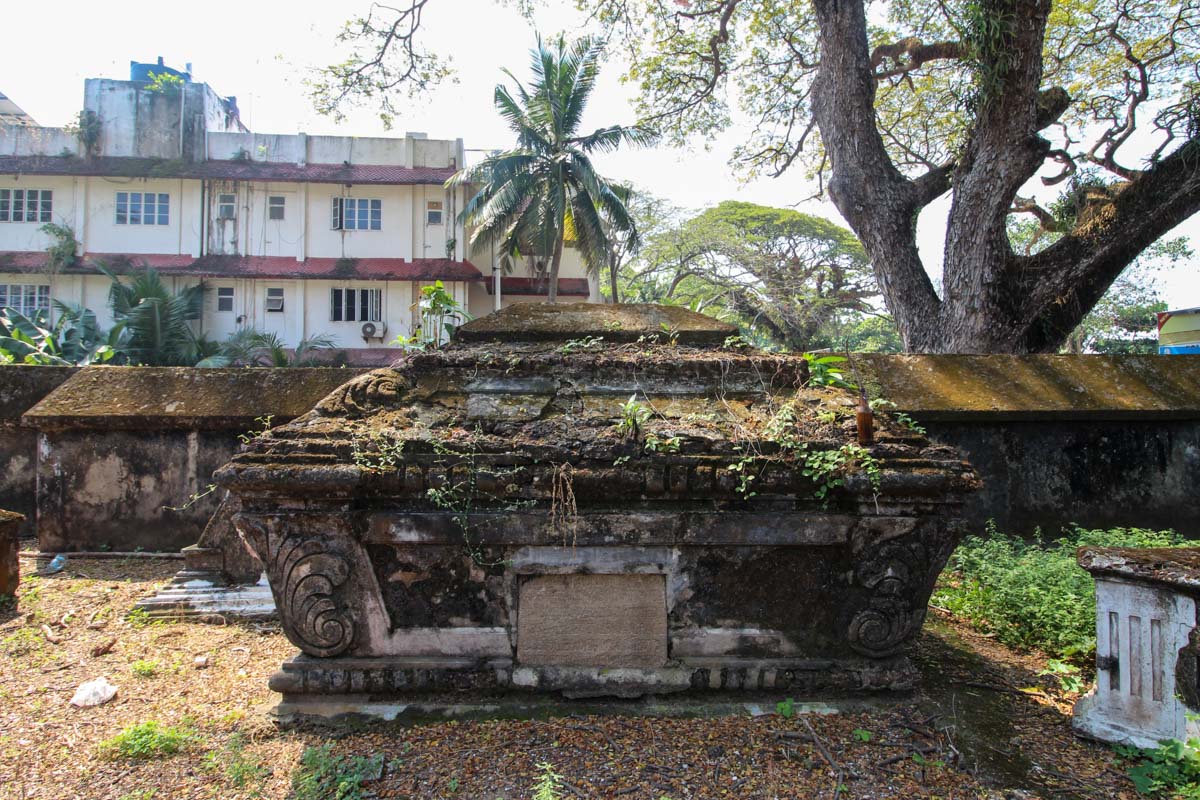
Read the article on Aletta Augustina Thiel.
3. Jacob Bernard Weinsheimer (1745 - 1790) [D7]
The monument consists of a column placed on a tomb with a plaque. The text: Hier Rust /ter saligen opstanding / het lyk van de / weledelen manhaften Heer / Jacob Bernard Weinsheimer / in leven kapitain van militair / gebooren te Solsenheim / den 25 November 1745 / obiit den 1ste Maart 1790. In translation: Here rests / awaiting his resurrection / the well-born / sir / Jacob Bernard Weinsheimer / during his life captain of the military / born in Solsenheim/ on 25 November 1745 / died on 1 March 1790.
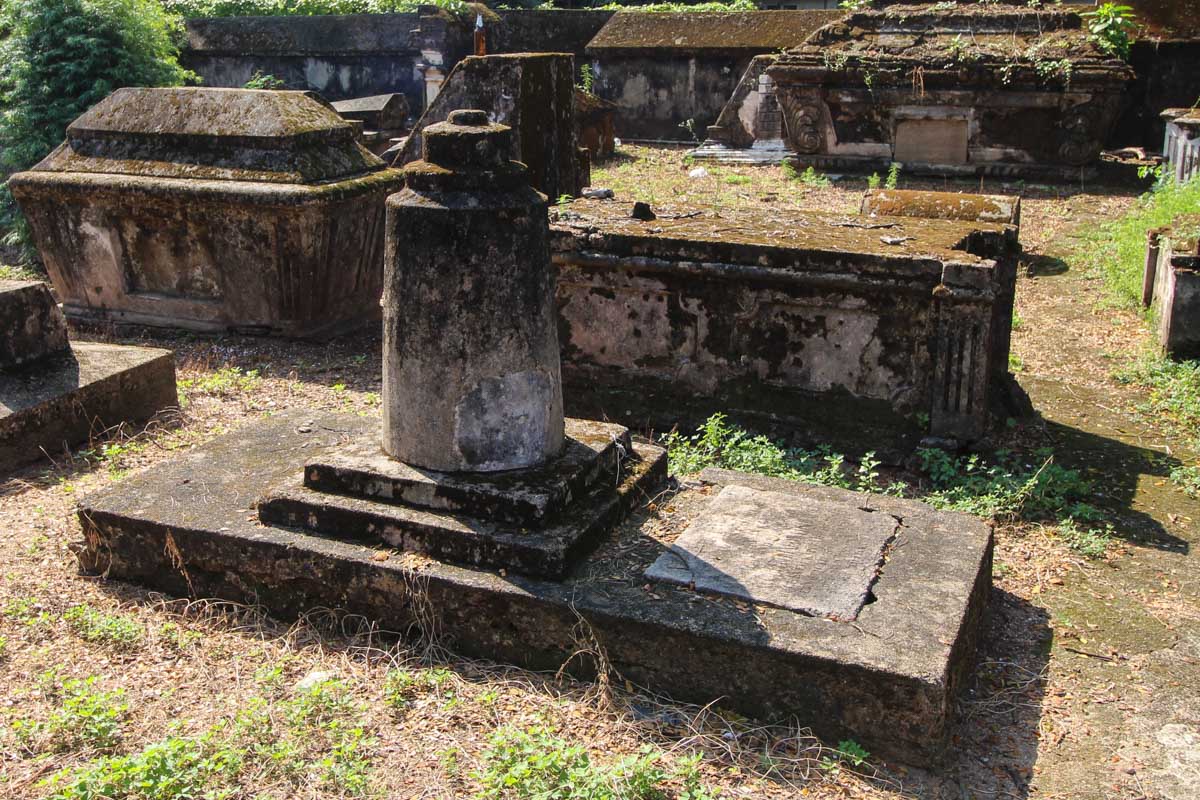 Tomb of Jacob Bernard Weinsheimer (photo Leon Bok, 2020)
Tomb of Jacob Bernard Weinsheimer (photo Leon Bok, 2020)
Read the article on Jacob Bernard Weinsheimer.
4. Not found: Van Haeften Van Shenar
A. Singh refers to List of European, &c., Tombs in the Malabar District (Calicut 1894). Printed at the Malabar Collectorate Press, as the source for this monument. Date mentioned: 1st March 1790, aged 44 years.
No further information on Van Haeften Van Shenar
5. Johannes van Blankenberg (1749 - 1794) [E5]
Van Blankenberg died on 2 April 1794, at the age of 44, and was buried in the cemetery in Fort Kochi. The funerary monument has a striking display of a coffin on top as a symbol of mortality. The upright stone of the monument is richly decorated and has in the edge a plant pattern trimmed with rope. The image in the center is somewhat weathered, but two angel figures are clearly visible. With a sextant on both sides that refers to Van Blankenberg's role as sea captain. Under the sextants there seems to be a basket with flowers or food, with an anchor and rope next to it. The text: Hier rust / Ter zalige opstandinge het lyk / Van wylen den E. heer / Johannes van Blankenberg / in leven kapitain ter zee en Equipagemeester / Gebooren te Nieuwvliet in Staats / Vlaanderen de 19 mai 1749 Obit den 2 April / Ao 1794. In translation: Here rests / awaiting his resurrection the corps / of the late sir / Johannes van Blankenberg / in life captain at sea and ‘equipagemeester’ / Born in Nieuwvliet in Staats / Vlaanderen on 19 May 1749. Died April / Anno 1794.
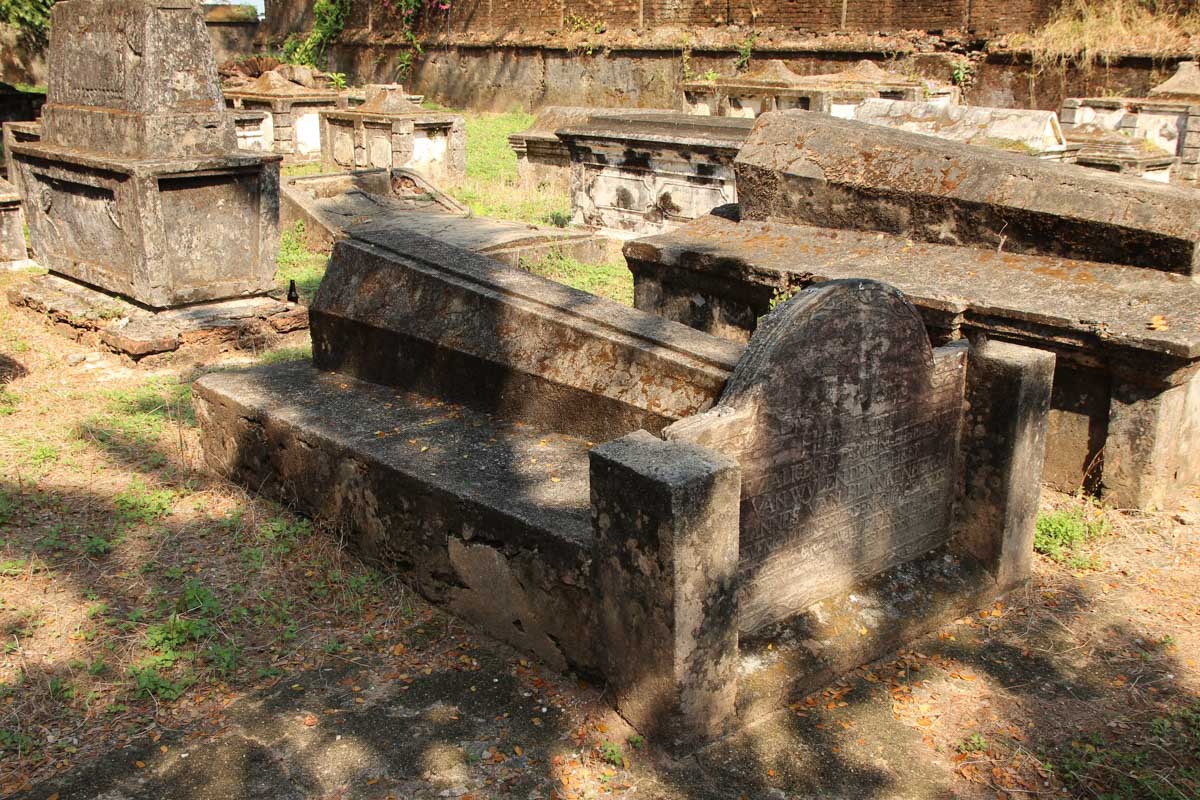 Tomb of Johannes van Blankenberg (photo Leon Bok, 2020)
Tomb of Johannes van Blankenberg (photo Leon Bok, 2020)
Read the article on Johannes van Blankenberg.
6. Johan Adam Cellarius (1740 - 1796) [D3]
The design of the monument does not appear original. The Latin text on the stone reads: Piis manibus / J.A. CellariiUlmensis / Obiit 15 Junii 1796. In translation: Devote to the devout soul of / J.A. Cellarius from Ulm / died 15 June;1796.]
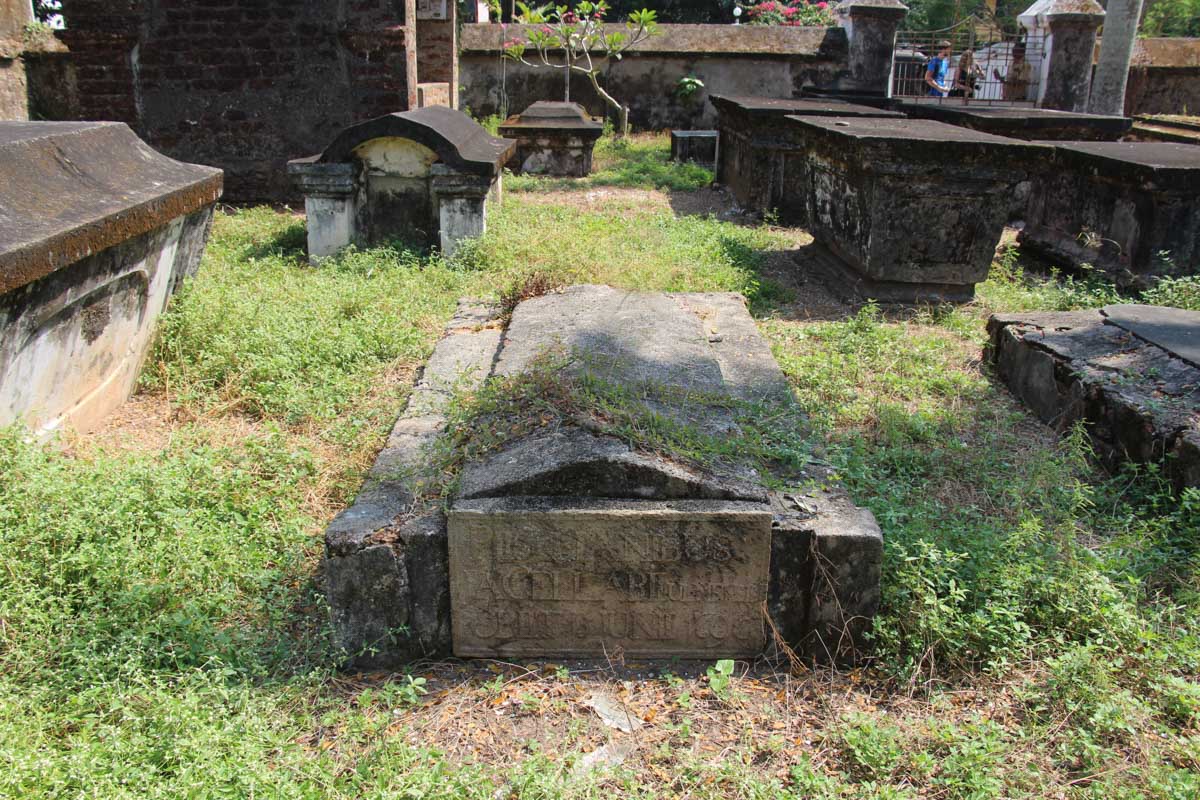
Read the article on Johan Adam Cellarius.
7. Not found: Jacob Krantz (1735 - 1787) and Maria de Rode (1771 - 1798)
The tombstone of Jacob Krantz and Maria Elisabeth de Rode was listed in Cotton's 'List of inscriptions on tombs or Monuments in Madras' (1905/1945), but is missing from later inventories. The monument may still be present at the Dutch Cemetery, but the text might be illeglible or the text plaque is missing. Thanks to Cotton we do know the inscription on the monument. The text: Hier onder rust d'E. Heer Jacob Krantz van Edenburg, Kapiteen Lieutenant en commandeur der artillerie overleden den 26 Januar. 1787 oud 51 jaaren 11 maanden en 12 dagen, en syne gedopteerde dochter Maria Elizabeth Rode van Kolombo huysvrouw van den boekhouder Johan Gaspar Krantz overleden 10 Jan. 1798 oud 26 jaaren 2 maanden en 19 dagen. In translation: Here rests the honourable sir Jacob Krantz van Edenburg, captain-lieutenant en commander of artillery died 26 January 1787, being of age 51 years 11 months and 12 days, and his adopted daughter Maria Elizabeth Rode van Kolombo housewife of bookkeeper Johan Gaspar Kranz died 10 January 1798 being of age 26 years 2 months and 19 days.
Read the article on Jacob Krantz and Maria de Rode.
8. Adriaan Poolvliet (before 1736 - 1799) [K6]
The monument for Adriaan Poolvliet on the Dutch Cemetery in Fort Kochi has a classic design in the form of a cippus with temple-like elements on all four sides, such as pilasters and a frieze withblock elements. The text is still readable with some effort. It reads: Hier rust het kil en / oud gebeente van / wijlen den heer / Adriaan Poolvliet / In leeven onderkoop / man en gen. Opperhoofd van / Koilan en Kannanoor obiit / 10 september 1799. In translation: Here rests the chill and / cold bones of / the late sir / Adriaan Poolvliet / In his life junior merchant / and gen. Director of / Koilan and Kannnoor died / 10 September 1799.
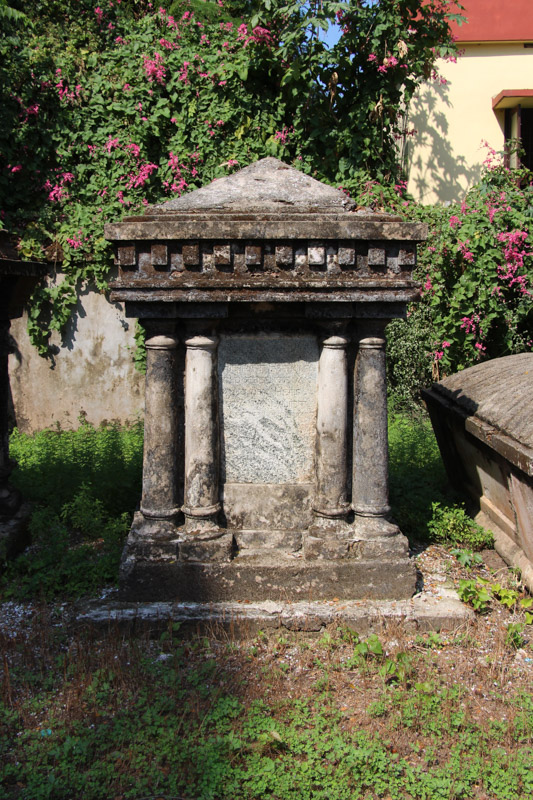 Tomb of Adriaan Poolvliet (photo René ten Dam, 2020)
Tomb of Adriaan Poolvliet (photo René ten Dam, 2020)
Read the article on Adriaan Poolvliet.
9. C & C (1799) [B7]
This small obelisk on a basement named Dutch/VOC by Barendsen in 1966. The inscription on the small plaque on the basement reads: C & C / 14 Oct 1799. This monument was not named by Cotton.
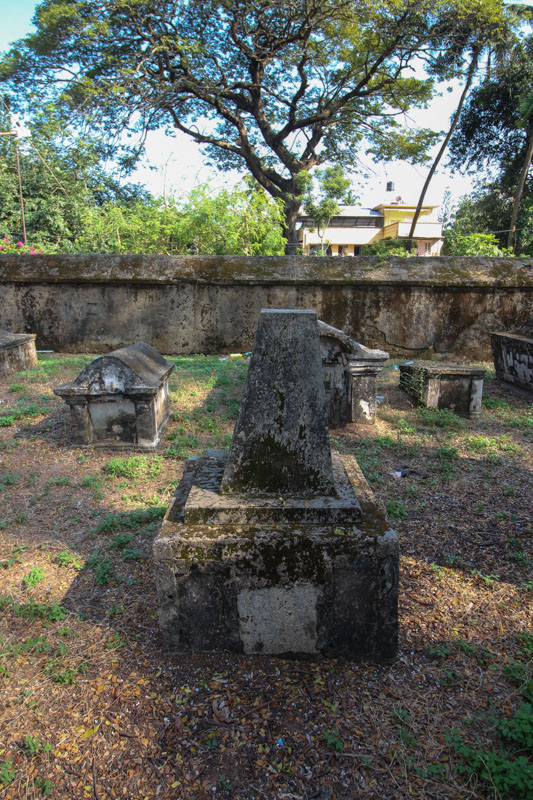 Obelisk (photo René ten Dam, 2020)
Obelisk (photo René ten Dam, 2020)
No further information on C & C.
10. Dorothea Lambertina Zeijsig (1774 - 1800) [F5]
After her death in 1800, Dorothea Zeijsig was buried in Fort Kochi. She has a simple grave monument with an upright plaque. The text reads: Hier rust / ter zaaliger wederopstanding / wylen de juffrouw Dorothea Lambertina Daimichen-Zeisig /geboren den 6 Nov 1774 /en obiit 10 Nov 1800. In translation: Here rests / awaiting her resurrection / the late miss Dorothea Lambertina Daimichen-Zeisig / born on 6 November 1774 / and died on 10 November 1800.
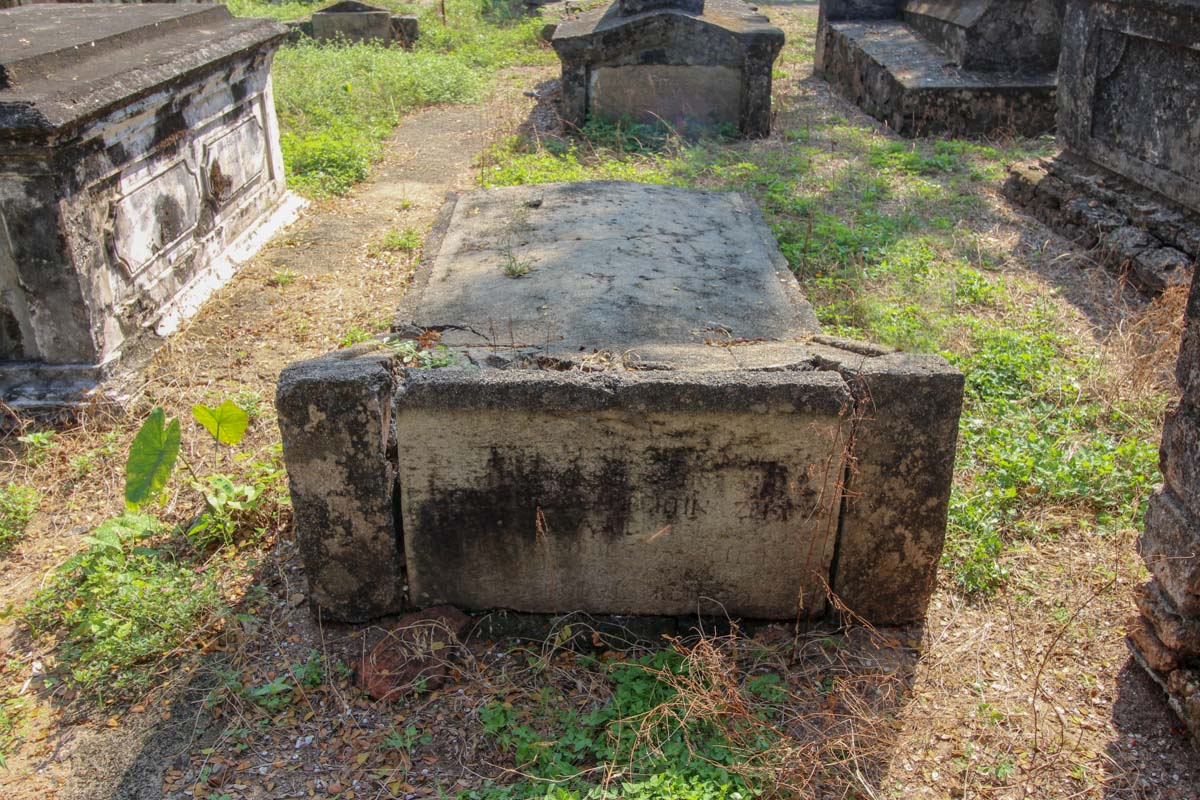 Tomb of Dorothea Lambertina Zeijsig (photo René ten Dam, 2020)
Tomb of Dorothea Lambertina Zeijsig (photo René ten Dam, 2020)
Read the article on Dorothea Lamertina Zeijsig.
11. Cornelia Elisabeth Vogt (1784-1804) [C8]
Cornelia was buried in the cemetery in Kochi. Her grave monument consists of a pedestal and a text plate, but the question is whether the two actually belong together. On the text plate a text with below it the symbol of a skull with bones. A common symbol for funerary monuments at the time. At the top the symbol of a vase with flowers. The text: Hier onder ligt / tot de opstanding / mejuffrouw / Cornelia Elisabeth Vogt / Huisvrouw / van den / Wel Gebooren /Baron von Ochsee / Geboren den 29 Oct. 1784 / Overld 11 Feby 1804. In translation: Beneath here lies / waiting to be resurrected / miss Cornelia Vogt / housewife /of the / well-born / Baron of Ochsee / Born on 29 Oct. 1784 / Died on 11 Feb. 1804.
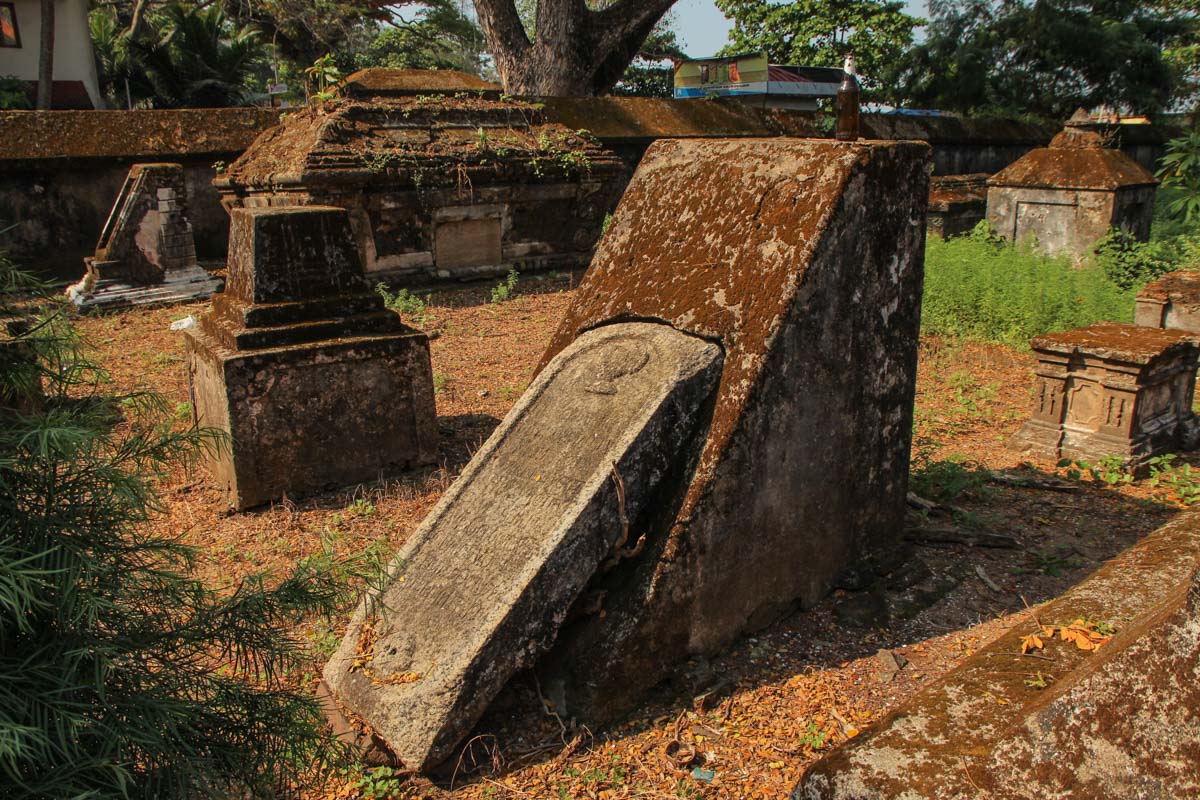
Read the article on Cornelia Elisabeth Vogt.
12. Not found: Daniel van der Sloot (1737 - 1807)
The tombstone of Daniel van der Sloot at the Dutch Cemetery was listed in Cotton's 'List of inscriptions on tombs or Monuments in Madras' (1905/1945), but is missing from later inventories. The monument may still be present at the Dutch Cemetery, but the text might be illeglible or the text plaque is missing.
Read the article on Daniel van der Sloot.
13. Samuel Homans ( - 1808) [D1]
A console with a text plaque. The text is hardly legible but it reads: Hier / onder rust / het lyk van / Samuel Homans / soon van den / […] / […] / […] / 1808 […]. In translation: Beneath / here rests / the corpse of / Samuel Homans / son of / […] / […] / […] / 1808 […].
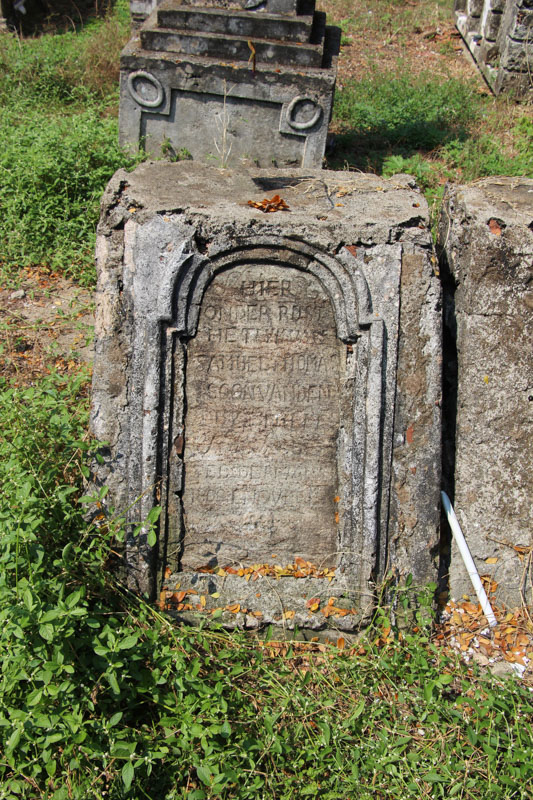 Monument of Samuel Homans (photo René ten Dam, 2020)
Monument of Samuel Homans (photo René ten Dam, 2020)
No further information on Samuel Homans.
14. Helena Elizabeth Muller (1811 - 1814) [H2]
A small plaque on a console for a young child. The text reads: Toegewyd / Aan de / Gedachtenis / van / Helena Eli- / zabeth / Muller / Geb. den 3 july / 1811 / Ove:n den 12 / December / 1814. In translation: Dedicated / to the memory / of / Helena Eli- / zabeth / Muller / Born on 3 July 1811 /Died on 12 / December / 1814. She was buried her 19 years after the British took control over Fort Kochi.
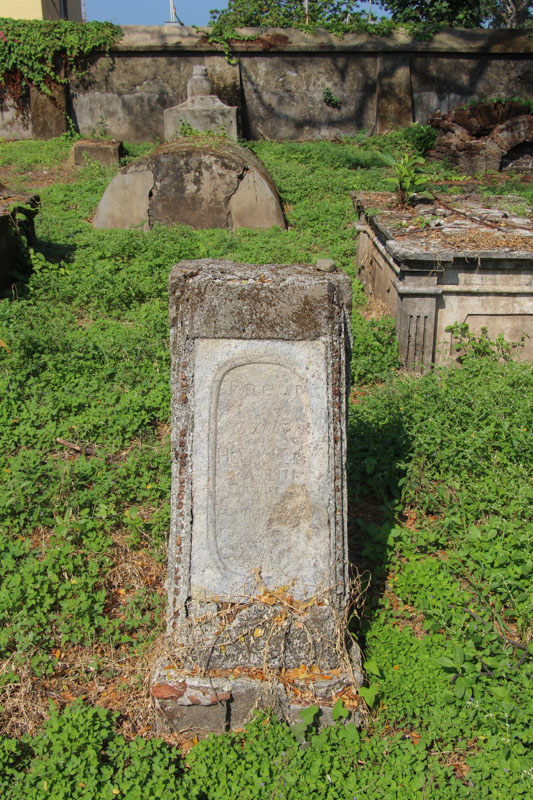 Monument of Helena Muller (photo René ten Dam, 2020)
Monument of Helena Muller (photo René ten Dam, 2020)
No further information on Helena Elizabeth Muller.
15. Johannes Wolff (1748 - 1815) and Catharina Sara Smit (1760 - 1820) [F10]
The tomb itself is in the style which was common during the British era. The deceased were buried in a grave and a large tomb was raised above it. ‘Hier ruhen ter zaligen opstandingen de / waardige overblyfzels van den / weled Heer en mejufvrouw Wolff / beide deugdzaam echtelieden / de eerste gend. geb. den 31 Maart 1748 en / overled: d: 18 Septb. 1815 / den tweede gend. Geb. den 22 maart 1760 en Overld: d: 15 Nov. D. 1820.’ In translation: ‘Here rests awaiting their resurrection, the dignified remains of the well-born sir en miss Wolff, both honest spouses the first named born on 31 March 1748 and died on 18 September 1815. The second named born on 22 March and died 15 November 1820.’
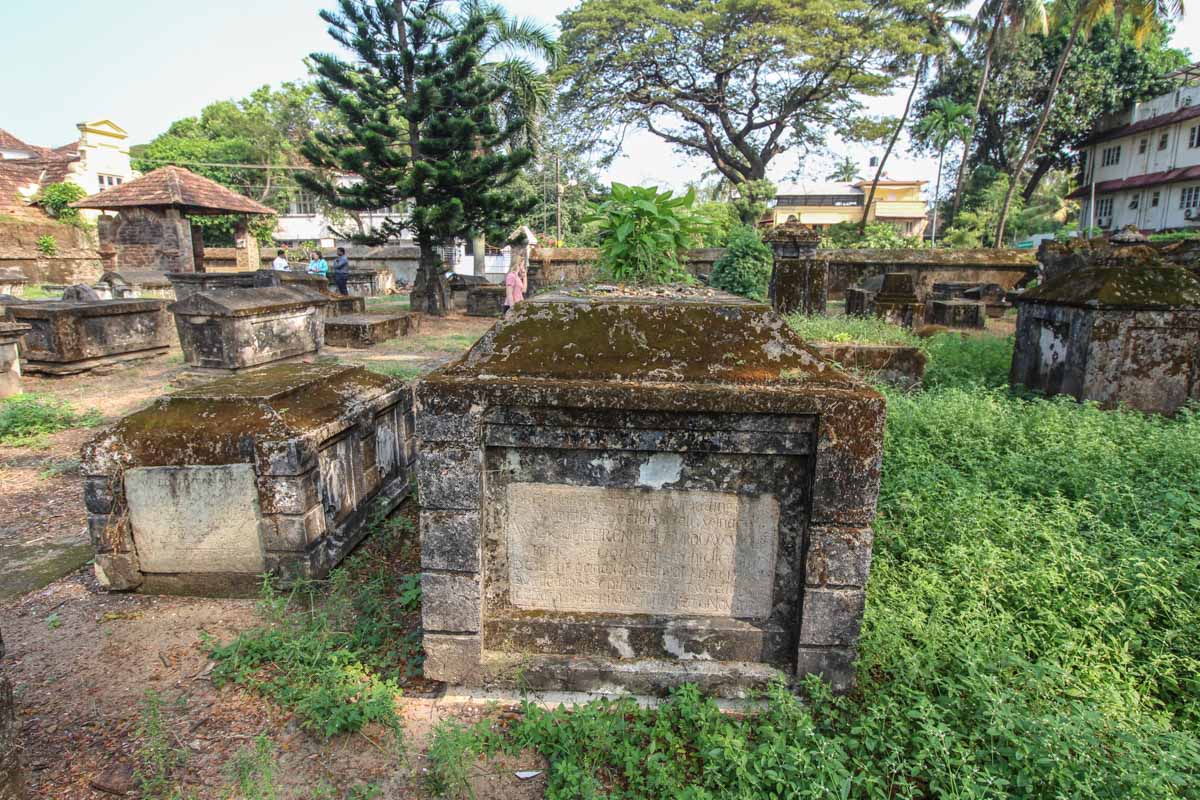 The tomb of Johannes Wolff and Catharina Sara Smit.
The tomb of Johannes Wolff and Catharina Sara Smit.
Read the article on Johannes Wolff and Catharina Sara Smit.
16. Unknown 82-year old [G5]
This tomb was not recorded in earlier inventories. It is a large tomb with a slab on top. The slab looks like marble and is very weathered. The Dutch inscription has mostly illegible, but some words can be recognized. At the bottom there is a symbol of a skull and bones. The text on the stone reads: [..] / […] /[…] /[…] /[…] / obit den / ouderdom / van 82 jaaren 2 maan / den en 14 dagen. In translation: [..] / […] /[…] /[…] /[…] / died / at the age / of 82 years 2 months / and 14 days.
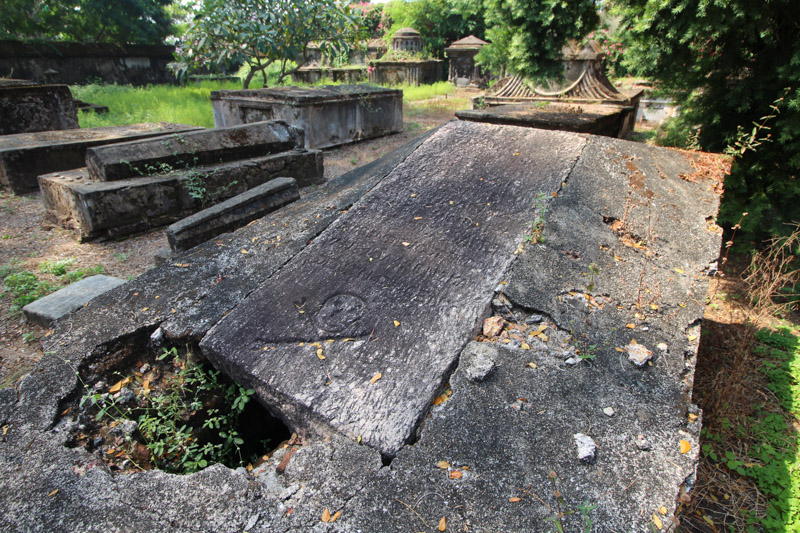 Tomb of an unknown 82-year old (photo René ten Dam, 2020)
Tomb of an unknown 82-year old (photo René ten Dam, 2020)
No further information.
- Last updated on .


